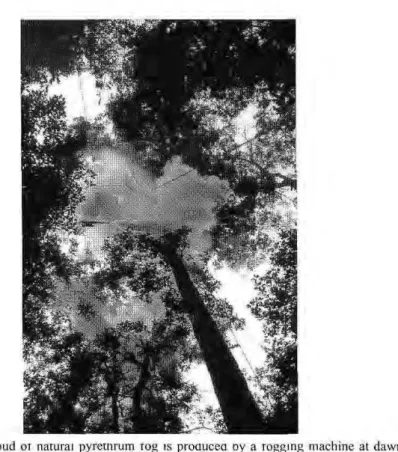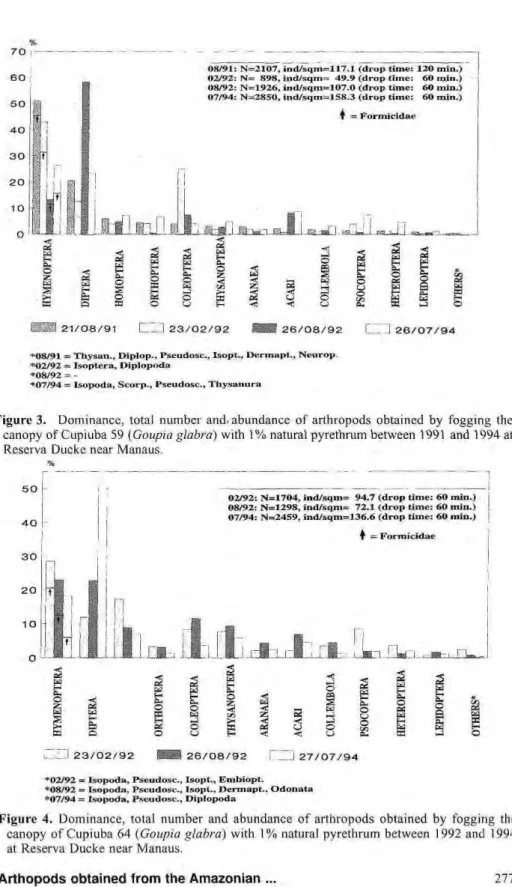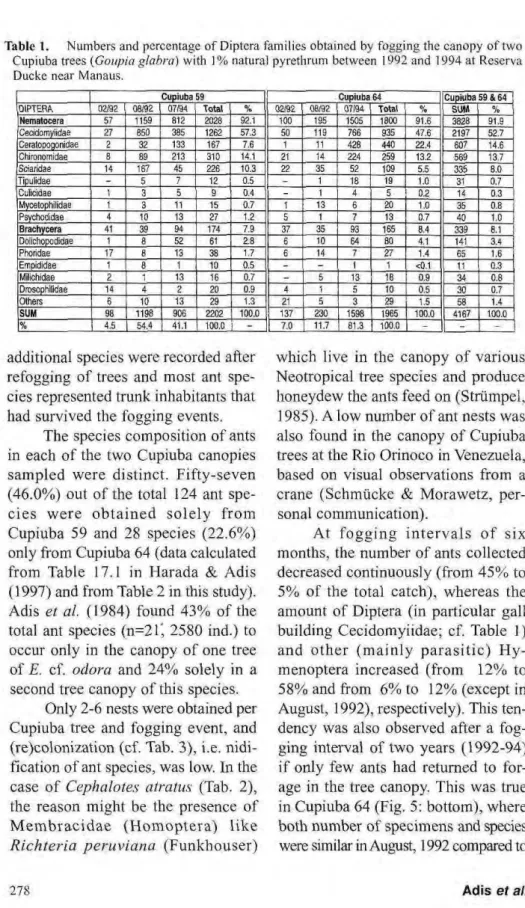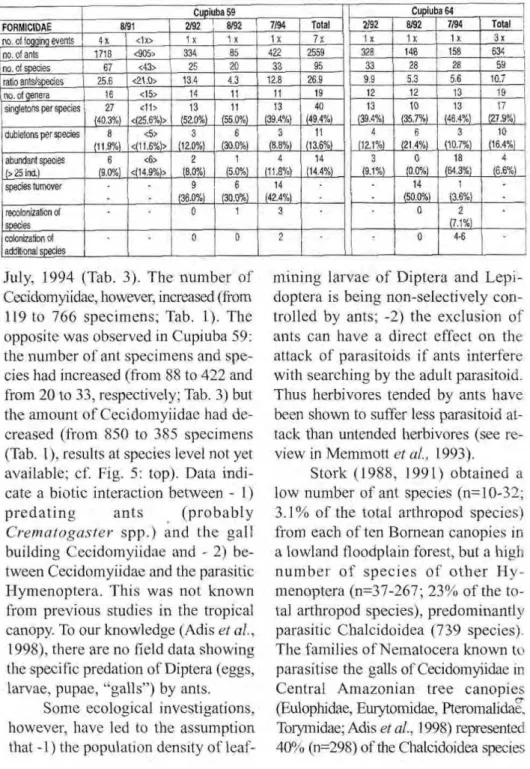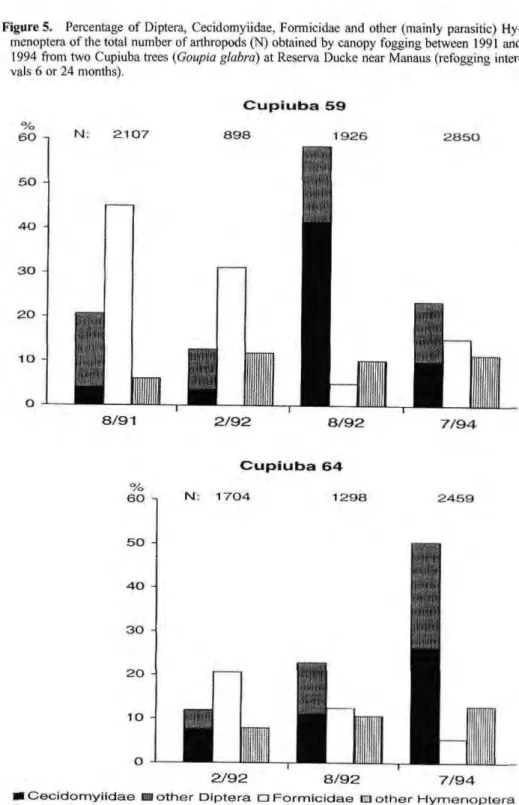ARTHROPODS OBTAINED FROM THE AMAZONIAN TREE
SPECIES "CUPIUBA"zyxwvutsrqponmlkjihgfedcbaZYXWVUTSRQPONMLKJIHGFEDCBA (Goupia glabra) BY REPEATED CANOPY FOGGING WITH NATURAL PYRETHRUM
Joachim ADIS1
, Ana Yoshi HARADA2
, Claudio Ruy V. da FONSECA3
, Wilfried PAARMANN4
, José Albertino RAFAEL3 zyxwvutsrqponmlkjihgfedcbaZYXWVUTSRQPONMLKJIHGFEDCBA
A B S T R A C TzyxwvutsrqponmlkjihgfedcbaZYXWVUTSRQPONMLKJIHGFEDCBA — Two canopies of a widely distributed Amazonian tree species,zyxwvutsrqponmlkjihgfedcbaZYXWVUTSRQPONMLKJIHGFEDCBA Goupia glabra Aubl.
(Celastraceae, height 38 and 45m) were fogged several times with 1% natural pyrethrum during the
rainy and dry seasons (1991-1994) in the Adolpho Ducke Forest Reserve near Manaus/Brazil. Between 50 and 158 ind./m2
of arthropods were obtained per tree and fogging event. Hymenoptera, mostly Formicidae, and Diptcra dominated. A total of 95 ant species occurred on a single tree. Most
ants were permanently foraging in the canopy and their recolonization after fogging seems to follow stochastic pathways. Data indicated an interaction between - 1) predating Formicidae and gall building Cecidomyiidae and - 2) Cecidomyiidae and the parasitic Hymenoptera.
Key words: Canopy fogging, pyrethrum, arthropods, recolonization, interactions, Amazon, Neotropics.
Artrópodos Obtidos Através de Nebulização Repetitiva da Copa de uma Árvor e Amazônica, " C u p i u b a " (Goupia glabra), com Piretróiide N a t u r a l .
R E S U M O — Duas copas de uma espécie de árvore amplamente distribuída na Amazônia, Goupia glabra Aubl. (Celastraceae, altura 38 e 45m) foram renebulizadas várias vezes com píretro natural 1%, durante o período chuvoso e seco (1991-94) na Reserva Florestal Adolpho Ducke próximo de Manaus/Brasil. Entre 50 e 158 ind./m2
de artrópodos foram obtidos por árvore e evento de nebulização. Hymenoptera, na sua maioria Formicidae, e Diptera dominaram. Um total de 95 espécies de formigas ocorreram numa única árvore. A maioria das formigas estava permanentemente forrageando na copa e a sua recolonização depois a nebulização parece seguir vias estocásticas. Os dados sugerem uma interação entre Formicidae e Cecidomyiidae (construindo galhas) e Cecidomyiidae e Hymenoptera parasítica.
Palavras-chave: Nebulização de copas, píretro, artrópodos, recolonização, interações, Amazônia, Neotrópicos.
1
Max-Planck-Institute for Limnology, Tropical Ecology Working Group, Postfach 165, D-24302 Ploen, Germany.
2
Museu Paraense Emílio Goeldi, Departamento de Zoologia, Caixa Postal 399, 66.040-170, Belém, Pará, Brazil.
3
Instituto Nacional de Pesquisas da Amazônia (INPA), CPEN, Caixa Postal 4 7 8 , 69011-970 Manaus/AM, Brazil,
4
Fachhochschule Hildesheim/Holzminden, Fachbereich Forstwirtschaft und Umweltmanagement, Büsgenweg 1A, D-37077 Göttingen, Germany.
INTRODUCTION
One possibility to explain the high within-community diversity of arthropods in the tropical canopy is that continuous stochastic local distur-bances in nature are assumed to pre-vent the achievement of any long-term equilibrium (climax) state. These
emerge. This is in contrast to the so-called deterministic equilibrium mod-els which are based on the ecological niche. Each organism maintains a
de-fined position in its environment and, driven by competition, the system runs through defined successional stages and ends up with a structurally pre-d i c t a b l e c l i m a x e q u i l i b r i u m ( s e e Linsenmair (1990) for details). The purpose of this study was to cause local disturbances and make sites va-cant by refogging the canopy of a widely distributed Amazonian tree spe-cies. Data allow a first insight into the composition and interaction of the ar-thropod guild in the Neotropical canopy. In particular, into the patterns and dy-namics of recolonization by species of common arthropod groups. In this con-tribution we focus on Hymenoptera,
es-pecially the Formicidae and Diptera. zyxwvutsrqponmlkjihgfedcbaZYXWVUTSRQPONMLKJIHGFEDCBA
MATERIAL AND METHODS
Our study area, the Adolpho Ducke Forest Reserve ("Reserva Ducke") is covered by 90 km2
of mostly undisturbed rainforest on terra firme latosol and is located 26 km north-east of Manaus (02°55'S, 59°59'W). It be-longs to the National Institute for Ama-zonian Research (INPA) and represents one of the most intensively studied
up-land forest sites in Central Amazonia
(e.g. AdiszyxwvutsrqponmlkjihgfedcbaZYXWVUTSRQPONMLKJIHGFEDCBA et al, 1984,1997; Hero, 1990;
Hôfer et al, 1994; Penny & Arias, 1982; Prance, 1990; Willis, 1977).
Sampling was conducted on two specimens of the tree species Goupia
glabra Aubl. (Celastraceae; common
name "Cupiuba") which has a high local abundance and is widely
distrib-uted in Amazonian upland forests (Bra-zil, Colombia, Venezuela and the Guianas; Loureiro & Silva, 1968).
The first tree sampled, Cupiuba 59 (height 45m, crown diameter approxi-mately 15m, contact to neighbouring tree canopies sporadical, no lianes nor epiphytes) was fogged with a Swingfog SN 50 two times per day in August 1991 (dry season; Ribeiro & Adis, 1984) on two consecutive days. The fogging ma-chine was hoisted into the lower canopy on a rope and pulley system early in the morning. Release of the insecticide (Fig. 1) was controlled from the ground by radio-control. Subsequently, the fog was directed to all parts of the crown by ro-tating the fogger round 180° with the rope from which it was suspended (Erwin, 1983). As knockdown agent, a
FigurezyxwvutsrqponmlkjihgfedcbaZYXWVUTSRQPONMLKJIHGFEDCBA 1. A cloud OT natural pyretnrum rog is proaucea oy a togging machine at dawn and
rises through the canopy of a 45m highzyxwvutsrqponmlkjihgfedcbaZYXWVUTSRQPONMLKJIHGFEDCBA Goupia glabra (Cupiuba 59; photo J. Adis).
Figure 2. Funnel-shaped collecting trays are suspended from ropes under the canopy of Goupia
walls with a garden sprayer filled with 70% ethanol into plastic bottles at-tached to the funnel outlet (Erwin,
1989). Cupiuba 59 was refogged after 6 or 24 months with 1% natural pyre-thrum (without synergist) during the
rainy season (February, 1992) and the dry season (August, 1992 and July,
1994).
A second tree specimen, Cupiuba 64 (height 38m, crown diameter about 14m, contact to neighbouring trees sporadical, no lianes nor epiphytes) was fogged for the first time with 1% natu-ral pyrethrum (without synergist) in February, 1992 (rainy season) and refogged 6 and 24 month later during the dry season (August, 1992 and July, 1994). This tree was about 1 km distant from Cupiuba 59. Further details of study site and fogging methodology are
given in AdiszyxwvutsrqponmlkjihgfedcbaZYXWVUTSRQPONMLKJIHGFEDCBA et ai, (1997). Relative
abundances (ind./m2
) represent the cal-culated mean of arthropods obtained in the 18 collecting trays which were in-stalled below the canopy of each tree
per fogging event. zyxwvutsrqponmlkjihgfedcbaZYXWVUTSRQPONMLKJIHGFEDCBA
RESULTS AND DISCUSSION
B e t w e e n 898 and 2 8 5 0 arthropods (50 -158 ind./m2
) were col-lected per fogging event during the dry and rainy seasons in the 18 trays in-stalled below the canopies of Cupiuba 59 and 64 (Figs. 3, 4). Hymenoptera (51%), mostly Formicidae (45%) and Diptera (58%) dominated. The higher proportion of Coleoptera during the r a i n y season (February, 1992) on Cupiuba 59 was due to Chrysomelidae (12 spp.). A total of 95 ant species were obtained from the canopy of one single
tree (Tab. 2: Cupiuba 59; cf. Harada & Adis, 1997). This is close to the total number of ant species recorded from Germany (n=105; Seifert, 1993).
The composition of the arthro-pod fauna in the canopy may differ between tree species. For example, in contrast to the results obtained from Cupiuba, the sample density of Hy-menoptera and Coleoptera collected from the canopies of Eschweilera cf.
odor a (Lecythidaceae; height 30-35m)
and Dipteryx alata (Leguminosae; height 30m) in the same forest reserve was higher than that of Diptera. Half the species of ants obtained from D.
alata did not occur on E. cf. odora
(Adis et ai, 1984).
08/91: N=2107, ind/sqm=117.1 (dro p time: 120 min.) 02/92: N = 898, ind/sqm= 49.9 (dro p time: 60 min.) 08/92: N=1926, ind/sqm=107.0 (dro p time: 60 min.) 07/94: N=28S0, ind/sqm=IS8.3 (dro p time: 60 min.)
^ = Formicidae zyxwvutsrqponmlkjihgfedcbaZYXWVUTSRQPONMLKJIHGFEDCBA
í i 3 _ W — L - E S .
JL
. 2 1 / 0 8 / 9 1zyxwvutsrqponmlkjihgfedcbaZYXWVUTSRQPONMLKJIHGFEDCBA L U 2 3 / 0 2 / 9 2 ' 2 6 / 0 8 / 9 2 j 2 6 / 0 7 / 9 4
*08/91 = T hy san., Diplop., Pse udo sc , Isopt., Dermapt ., Ne uro p. *02/92 = Isoptera, Diplopoda
»08/92 =
-*07/94 = Isopoda, Scorp., Pse udo sc , T hy sanura
FigurezyxwvutsrqponmlkjihgfedcbaZYXWVUTSRQPONMLKJIHGFEDCBA 3 . Dominance, total number and-abundance of arthropods obtained by fogging the canopy of Cupiuba 59zyxwvutsrqponmlkjihgfedcbaZYXWVUTSRQPONMLKJIHGFEDCBA (Goupia glabra) with 1% natural pyrethrum between 1991 and 1994 at
Reserva Ducke near Manaus.
02/92: N=1704, ind/sqm= 94.7 (dro p time: 60 min.)zyxwvutsrqponmlkjihgfedcbaZYXWVUTSRQPONMLKJIHGFEDCBA i
08/92: N=1298, ind/sqm= 72.1 (dro p time: 60 min.) \ 07/94: N=2459, ind/sqm=136.6 (dro p time: 60 min.) i
4 = Formicidae
*02/92 = Isopoda, Pseudosc., Isopt., Embiopt . *08/92 = Isopoda, Pseudosc., Isopt., Dermapt ., Odonat a *07/94 = Isopoda, Pse udo sc , Dipiopoda
Table 1. Numbers and percentage of Diptera families obtained by fogging the canopy of two Cupiuba treeszyxwvutsrqponmlkjihgfedcbaZYXWVUTSRQPONMLKJIHGFEDCBA {Goupia glabra) with 1% natural pyrethrum between 1992 and 1994 at Reserva
Ducke near Manaus. zyxwvutsrqponmlkjihgfedcbaZYXWVUTSRQPONMLKJIHGFEDCBA
Cupiuba 59 Cupiuba 64 Cupiuba 59zyxwvutsrqponmlkjihgfedcbaZYXWVUTSRQPONMLKJIHGFEDCBA & 64 zyxwvutsrqponmlkjihgfedcbaZYXWVUTSRQPONMLKJIHGFEDCBA DI PTERA. Q2/92 08/92 Q7/94 Total % 02/92 Q8Í92 07/94 Total % SU?A %
Nematocera 57 1159 812 2028 92.1 100 195 1505 1800 91.6 3828 91.9 Cecidom yiidae 27 850 385 1262 57,3 50 119 766 935 47.6 2197 52.7 Cerat opoqonidae 2 32 133 167 7.6 1 11 428 440 22.4 607 14.6 Chironomidae 8 89 213 310 j 14.1 21 14 224 259 13.2 569 13.7 Sciaridae 14 167 45 226 j 10.3 22 35 52 109 5.5 335 8.0
Tipulidae zyxwvutsrqponmlkjihgfedcbaZYXWVUTSRQPONMLKJIHGFEDCBA- 5 zyxwvutsrqponmlkjihgfedcbaZYXWVUTSRQPONMLKJIHGFEDCBA~ 12 0.5 zyxwvutsrqponmlkjihgfedcbaZYXWVUTSRQPONMLKJIHGFEDCBA- 1 18 19 1.0 31 0.7 j
Culicidae 1 3 5 9 0.4 zyxwvutsrqponmlkjihgfedcbaZYXWVUTSRQPONMLKJIHGFEDCBA
-
1 4 5 0.2 14 0.3Mycet ophilidae 1 3 11 15 0.7 1 13 6 20 1.0 35 0.8 Psychodidae 4 10 13 27 1.2 5 1 7 13 0.7 40 1.0
Brachycera 41 39 94 174 7.9 37 35 93 165 8.4 339 8.1 Dolichopodidae 1 8 52 61 2.8 6 10 64 80 4.1 141 3.4
Phoridae 17 8 13 38 1.7 6 14 7 27 1.4 65 1.6
Em pididae 1 8 1 10 0.5
--
1 1 < 0 1 11 0.3 Milichidae 2 1 13 16 0.7-
5 13 18 0.9 34 0.8Drosophilidae 14 4 2 20 0.9 4 1 5 10 0.5 30 0.7
Ot hers 6 10 13 29 1.3 21 5 3 29 1.5 58 1.4
SUM 98 1198 906 2202 100.0 137 230 1598 1965 100.0 4167 100.0
% 4.5 54.4 41.1 100.0
-
7.0 11.7 81.3 100.0 - -zyxwvutsrqponmlkjihgfedcbaZYXWVUTSRQPONMLKJIHGFEDCBA-additional species were recorded after refogging of trees and most ant spe-cies represented trunk inhabitants that had survived the fogging events.
The species composition of ants in each of the two Cupiuba canopies sampled were distinct. Fifty-seven (46.0%) out of the total 124 ant spe-cies w e r e o b t a i n e d solely from Cupiuba 59 and 28 species (22.6%) only from Cupiuba 64 (data calculated from Table 17.1 in Harada & Adis (1997) and from Table 2 in this study). Adis et ai (1984) found 4 3 % of the total ant species (n=2T, 2580 ind.) to occur only in the canopy of one tree of E. cf. odora and 24% solely in a second tree canopy of this species.
Only 2-6 nests were obtained per Cupiuba tree and fogging event, and (re)colonization (cf. Tab. 3), i.e. nidi-fication of ant species, was low. In the case of Cephalotes atratus (Tab. 2), the reason might be the presence of M e m b r a c i d a e ( H o m o p t e r a ) l i k e
Richteria peruviana (Funkhouser)
which live in the canopy of various Neotropical tree species and produce honeydew the ants feed on (Striimpel, 1985). A low number of ant nests was also found in the canopy of Cupiuba trees at the Rio Orinoco in Venezuela, based on visual observations from a crane (Schmücke & Morawetz, per-sonal communication).
Table 2.zyxwvutsrqponmlkjihgfedcbaZYXWVUTSRQPONMLKJIHGFEDCBA Ant species obtained from two Cupiuba treeszyxwvutsrqponmlkjihgfedcbaZYXWVUTSRQPONMLKJIHGFEDCBA (Goupia glabra) at Reserva Ducke near Manaus by refogging the canopy after two years with 1% natural pyrethrum during lhe dry season (July, 1992). Data
on ant species collected during previous fogging events are given in Harada & Adis (1997).
FORMICIDAE Cupiuba 59 Cupiuba 64 Total X a t zyxwvutsrqponmlkjihgfedcbaZYXWVUTSRQPONMLKJIHGFEDCBA?
Subf. Dolichoderinae zyxwvutsrqponmlkjihgfedcbaZYXWVUTSRQPONMLKJIHGFEDCBA
0
Azteca nr. detpini zyxwvutsrqponmlkjihgfedcbaZYXWVUTSRQPONMLKJIHGFEDCBA- 9 9 2,6 zyxwvutsrqponmlkjihgfedcbaZYXWVUTSRQPONMLKJIHGFEDCBAX ?
Dolichoderus diversus 1 - 1 5,1 X
Dolichoderus lutosus 4 - 4 3,4 X
° Dolichoderus rugosus 1 - 1 10,6 X
° Tapinoma amazonicum 1 2 3 1,5 X ?
" Tapinoma ramulorum zyxwvutsrqponmlkjihgfedcbaZYXWVUTSRQPONMLKJIHGFEDCBA- 3 3 1,8 X ?
Subf.zyxwvutsrqponmlkjihgfedcbaZYXWVUTSRQPONMLKJIHGFEDCBA Formicinae
Camponotus abdominalis A - 1 1 6,5 X j
Camponotus alboannulatus A 1 - 1 4,8 X
Camponotus alboannulatus B - 1 1 4,5 X
" Camponotus brasiliensis 1 32 3 3 3,2 X X '
° Camponotus coptobregma 2
- 2 5,7 X
Camponotus crassus 2 8 - _j 2 8 3,7 X ?
° Camponotus eurynota 6 6 3,3 X
0
Camponotus femuratus 1 4,7 X
Camponotus nr. abdominalis - 1 1 5 X
° Camponotus luederwaldti 2 - 2 3,1 X
Camponotus nr. bidens 7 23 3 0 3 X
° Camponotus pittieri 4 4 12 5 6 3 X
Camponotus rapax - 1 1 7,9 X ?
Camponotus sp. 34 7 - 7 3,7 X
0
Camponotus sp. 49 1 - 1 7 X
Dendromyrmex fabricii 1 - 1 5,7 X
Subf. Myrmicinae
Cephalotes atratus 129 15 144 10,1 X
Procryptocerus goeldii 6 7 1 3 4 xzyxwvutsrqponmlkjihgfedcbaZYXWVUTSRQPONMLKJIHGFEDCBA "I
Procryptocerus marginatus 15 5 20 5,8 x
Zacryptocerus duckei 1
- 1 3 X
° Zacryptocerus sp. 22 2
- 2 2,5 X ?
Crematogaster sp. 1 - 1 1 2 X ?
Crematogaster sp. 2 11 1 12 2,2 X ?
Crematogaster sp. 3 14 1 1 5 2,2 X ?
Crematogaster limata 3 - 3 2 , 7 X ?
Crematogaster sp. 7 8 - 8 2,6 X ?
Crematogaster sp. 8 - 6 6 I 2,5 X ?
Crematogaster sp. 9 1 - 1 2 X ?
Crematogaster sp. 10 8 8 9 9 7 1,9 X ?
Leptothorax (Nesomyrmex) sp. 2 19 1 20 1,6 X ?
" Leptothorax (Nesomyrmex) sp. 9 - 1* 3 X ?
° Megalomyrmex balzani - 2 2 7,6 X
" Pheidole sp. 11 11 - 11 1,4 X ?
" Pheidole sp. 15 5 5 1,4 X ?
° Pheidole sp. 18 13 1 3 1,1 X ?
° Pheidole sp. 55 1 - 1 1,6 X ?
° Pheidole sp. 68 I 1* 1 3,2 X ?
Solenopsis (Diplorhoptrum) sp. 8 1 1 1,1 X ?
0
Cyphomyrmex dentatus 2 2 1,9 X ?
Subf. Pseudomyrmecinae
° Pseudomyrmex elongatus 1 - 1 Í 3,1 X ?
° Pseudomyrmex oculatus 1 - 1 4,1 X ?
Pseudomyrmex pupa 3
- 3 6,5 X
Subf. Ponerinae f
0
Discothyrea sexarticulata - 1* 1 1,3 X ?
° Hypoponera sp. 33 - 1* 1 2 , 8 X ?
Total no. of ants 422 158 580
Total no. of species 33 28 50 37 2 12
Total no. of genera 11 13 17 16 2 2
Table 3 . Comparison of the ant fauna obtained from two Cupiuba treeszyxwvutsrqponmlkjihgfedcbaZYXWVUTSRQPONMLKJIHGFEDCBA (Goupia glabra) at Reserva Ducke near Manaus by fogging the canopy between 1991 and 1994. Data based on ant species given in Table
17.1 of Harada & Adis (1997) and in Table 2 of this study. (The insecticide applied was 1 % natural pyre-thrum, except at the fourth fogging event in August, 1991 during which synthetic pyrethrum Baythroid 0.15% was used; < > = data of the first fog event; see text for details).
Cupiuba 59 Cupiuba 64
FORMICIDAE 8/91 2/92 8/92zyxwvutsrqponmlkjihgfedcbaZYXWVUTSRQPONMLKJIHGFEDCBA j 7/94 Total 2/92 8/92 7/94 Total zyxwvutsrqponmlkjihgfedcbaZYXWVUTSRQPONMLKJIHGFEDCBA
no. of togqing events 1 4x <1x> 1 X 1x 1x zyxwvutsrqponmlkjihgfedcbaZYXWVUTSRQPONMLKJIHGFEDCBA7X zyxwvutsrqponmlkjihgfedcbaZYXWVUTSRQPONMLKJIHGFEDCBA1 I X 1x 1x 3x
no. of ants <905> 334 85 422 2559 328 148 634
no. of species 67 <43> 25 20 33 95 33 28 28 59
ratio ants/ species 25.6 <21.0> 13.4 4.3 , 12.8 26.9 9.9 5.3 5.6 10.7
TO. ot aenera 16 <15> 14 11 11 19 12 12 13 19
singletons per species 27 J40.3%) <11> <(25.6%)> 13 (52.0%) 11 (55.0%) 13 (39.4%) 40 (49.4%) 13 (39.4%! 10 (35.7%) 13 (46.4%) 17 (27.9%)
dubletons per species 8
(11.9%! <5> <{11.6%)> 3 (12.0%) 6 (30.0%) 3 (8.8%J_ 11 (13.6%) 4 (12.1%) 6 (21.4%) 3 (10.7%) 10 (16.4%)
abundant species
(> 25 ind.)
6 (9.0%) <6> <Í14.9%)> 2 (8.0%) 1 (5.0%) 4 (11.8%) 14 (14.4%) 3 (9.1%) 0 (0.0%) 18 (64.3%) 4 (6.6%)
species turnover 9
(36.0%) 6 (30.0%L 14 (42.4%) 14 (50.0%) 1 (3.6%) recolonization of species
0 1 3 0 2
(7.1%)
colonization of additional species
0 0 2 zyxwvutsrqponmlkjihgfedcbaZYXWVUTSRQPONMLKJIHGFEDCBA- 0 4-6
July, 1994 (Tab. 3). The number of Cecidomyiidae, however, increased (from
119 to 766 specimens; Tab. 1). The opposite was observed in Cupiuba 59: the number of ant specimens and
spe-cies had increased (from 88 to 422 and from 20 to 33, respectively; Tab. 3) but the amount of Cecidomyiidae had de-creased (from 850 to 385 specimens (Tab. 1), results at species level not yet available; cf. Fig. 5: top). Data indi-cate a biotic interaction between - 1) p r e d a t i n g ants ( p r o b a b l y
Crematogaster spp.) and the gall
building Cecidomyiidae and - 2) be-tween Cecidomyiidae and the parasitic Hymenoptera. This was not known from previous studies in the tropical canopy. To our knowledge (Adis et ah,
1998), there are no field data showing the specific predation of Diptera (eggs, larvae, pupae, "galls") by ants.
Some ecological investigations, however, have led to the assumption that -1) the population density of
leaf-mining larvae of Diptera and Lepi-doptera is being non-selectively con-trolled by ants; -2) the exclusion of ants can have a direct effect on the attack of parasitoids if ants interfere with searching by the adult parasitoid. Thus herbivores tended by ants have been shown to suffer less parasitoid at-tack than untended herbivores (see re-view in Memmott et at, 1993).
FigurezyxwvutsrqponmlkjihgfedcbaZYXWVUTSRQPONMLKJIHGFEDCBA 5. Percentage of Diptera, Cecidomyiidae, Formicidae and other (mainly parasitic) Hy-menoptera of the total number of arthropods (N) obtained by canopy fogging between 1991 and
1994 from two Cupiuba treeszyxwvutsrqponmlkjihgfedcbaZYXWVUTSRQPONMLKJIHGFEDCBA (Goupia glabra) at Reserva Ducke near Manaus (refogging
inter-vals 6 or 24 months). zyxwvutsrqponmlkjihgfedcbaZYXWVUTSRQPONMLKJIHGFEDCBA
6 0
5 0
4 0
3 0
2 0
1 0
-Nf: 2 1 0 7 zyxwvutsrqponmlkjihgfedcbaZYXWVUTSRQPONMLKJIHGFEDCBA
8/ 91
C u p i u b a 5 9
8 9 8 zyxwvutsrqponmlkjihgfedcbaZYXWVUTSRQPONMLKJIHGFEDCBA1 9 2 6 2 8 5 Ü
2 / 9 2 8 / 9 2 7 / 9 4
C u p i u b a 6 4
6 0
5 0
-4 0
3 0
-2 0
1 0
-N : 1 7 0 4 1 2 9 8 2 4 5 9
2 / 9 2 8 / 9 2 7 / 9 4
and 46% (n=667) of all specimens ob-tained on Borneo. The Diptera on Borneo amounted to 22% of the arthro-pod species and specimens collected. The Cecidomyiidae, Ceratopognidae, Chironomidae and Sciaridae repre-sented 9 1 % (n=3362) of the specimens and 69% (n=l 19) of the species of all the Nematocera obtained. At Manaus (Tab. 1), specimens of these groups amounted to 89% of the total Nematocera. The Cecidomyiidae represented 47 - 62% of the Nematocera specimens collected and at least 13 species (preliminary classification on morphospecies level). On Borneo, 26 species of Cecidomyiidae represented 15% of the total Nematocera specimens.
The data from tree canopies on Borneo suggest that a low number of ant species might result in a reduced predation of Cecidomyiidae galls by ants, which favours an interaction primarily between the parasitic Hymenoptera and the Cecidomyiidae. Field experiments might elucidate the general interactions between Formicidae, Cecidomyiidae and parasitic Hymenoptera in both Neotropical and Southeast Asian canopies of tropical low-land forests. At Manaus and at the Rio Orinoco, twigs of trees with Cecido-myiidae galls could be protected from ant attacks, e.g. by mesh-bags. On Borneo, carton nests of non-competitive ant species could be added to the canopy (Maschwitz, personal communication) and the response of gall building Cecidomyiidae monitored. In both cases, however, results have to be
compared on species level. zyxwvutsrqponmlkjihgfedcbaZYXWVUTSRQPONMLKJIHGFEDCBA
ACKNOWLEDGEMENTS
This study is part of a 6-year project on 'Mechanisms that maintain tropical
di-versity', funded by the German Research Foundation, the German Agency of Tech-nical Cooperation (GTZ: project 85.2522.2-06100) and the Brazilian Re-search Foundation (CNPq: project CNPq/ MPG 91.0304/90-4) since 1991. Sincere thanks are expressed to PD Dr. W.J. Junk and Dr. Maria Teresa Fernandez Piedade for logistical support in Manaus via the 'Projeto hNPA/Max-Planck'. We heartily thank all scientists of the diversity project and of LNPA, the technical staff of INPA as well as the participants of the postgradu-ate course 'Entomological Field Ecology' ofINPA/Univ. Amazonas (February 1992) who joined the canopy fogging studies. Dr. Helen Read, Bumham Beeches, Slough/ United Kindom, Dr. Terry L. Erwin, Smithsonian Institution, Washington D.C./USA, and Prof. Dr. Stefan Vidal, University of Giessen/Germany gave valuable comments which helped to
im-prove the manuscript.
Literature cited
Adis, J.; Lubin, Y.D.; Montgomery, G.G. 1984. Arthropods from the canopy of inundated and terra firme forests near Manaus, Bra-zil, with critical considerations on the
pyrcthrum-fogging technique.zyxwvutsrqponmlkjihgfedcbaZYXWVUTSRQPONMLKJIHGFEDCBA Studies on Neotropical Fauna and Environment.
19(4): 223-236.
Adis, J; Paarmann, W; Fonseca, C.R.V. da; Rafael, J.A. 1997. Knockdown efficiency of natu-ral pyrethrum and survival rate of living arthopods obtained by canopy fogging in Central Amazonia. In: Stork, N.E.; Adis, J.; Didham, R.K. (eds.) Canopy arthropods. Chapman ; Hall, London: 67-81.
Adis, J; Harada, A.Y.; Rafael, J.A.; Vidal, S. 1 9 9 8 . K o n t r o l l i e r e n A m e i s e n d i e Dipterenfauna neotropischer Baumkronen?
Verhandlungen Westdeutscher Entomolo-gentag Dusseldorf 1997
Erwin, T.L. 1983. Tropical forest canopies: the
last b i o t i c frontier.zyxwvutsrqponmlkjihgfedcbaZYXWVUTSRQPONMLKJIHGFEDCBA Bull. Em. Soc. America, 29(1): 14-19.
E r w i n , T.L. 1 9 8 9 . C a n o p y a r t h r o p o d biodiversity: a chronology of sampling techniques and results. Revista Peruana de Entomologia, 32: 71-77
Floren, A; Linsenmair, K.E. 1997a. Diversity and recolomzaüon dynamics of selected arthropod groups on different tree spe-cies in a lowland rainforest in Sabah, M a l a y s i a with s p e c i a l r e f e r e n c e to F o r m i c i d a e . In: Stork, N.E.; Adis, J.; Didham, R.K. (eds). Canopy arthropods. Chapman Hall, London: 333-381.
Floren, A; Linsenmair, K.E. 1997b. Diversity and recolonisation dynamics of arthropod communities in a lowland rain forest in Sabah, Malaysia. In: Ulrich, H. (ed) Tropi-ca! biodiversity! and systematics. Proceed-ings of the International Symposium on Biodiversity and Systematics in Tropical Ecosystems., Bonn, 1994. Zoologisches Forschungsinstitut und Museum Alexander Koenig, Bonn: 245-249.
Harada, A.Y.; Adis, J. 1997. The ant fauna of tree canopies in Central Amazonia: a first assessment. In: Stork, N.E.; Adis, J.; Didham, R.K. (eds). Canopy arthropods. Chapman ; Hall, London: 382-400.
Hero, J.M. 1990. An illustrated key to tadpoles o c c u r r i n g in the Central Amazonian rainforest, Manaus, Amazonas, Brazil. Amazoniana, 11(2): 201-262.
Hôfer, H.; Brescovit, A.D.; Adis, J.; Paarmann, W. 1994. The spider fauna of Neotropi-cal tree canopies in Central Amazonia: first r e s u l t s . Studies on Neotropical Fauna and Environment, 29( 1): 23-32.
Linsenmair, K.E. 1990. Tropische Biodiversitât: B e f u n d e und offene P r o b l e m e . Verhandlungen der Deutschen Zoologischen Gesellschaft, 83: 245-261.
Loureiro,A.A.; Silva, M.F. da 1968. Catálogo das madeiras da Amazonia. V o l . 1 , SUDAM, Belém. 433 p.
Memmott, J.; Godfray, H.C.J.; Bolton, B. 1993. Predation and parasitism in a tropical h e r b i v o r e c o m m u n i t y . Ecological Entomology. 18: 348-352.
Penny, N.D.; Arias, J.R. 1982. Insects of an Amazon forest. C o l u m b i a University Press, New York. 269 p.
Prance, G.T. 1990. The floristic composition of the forests of central Amazonian Brazil. In: Gentry, A.H. (ed). Four Neotropical Rainforests. Yale University Press, New Haven: 159-174.
Ribeiro, M. de N.G.; Adis, J. 1984. Local rain-fall variability - a potential bias for bio-ecological studies in the Central Amazon. Acta Amazônica, 14(1/2): 159-174.
Seifert, B . 1993. Die freilebenden Ameisen Deutschlands (Hymenoptera: Formicidae) und Angaben zu deren Taxonomie und Verbreitung. Abhandlungen und Berichtedes Naiurkundemuseums Gõrlitz, 67(3): 1 -44.
Stork, N.E. 1988. Insect diversity: facts, fictions and speculations. Biological Journal of the Linnean Society, 35: 321-337.
Stork, N . E . 1 9 9 1 . T h e composition of the arthropod fauna of Bornean lowland vain forest trees. Journal of Tropica I Ecology, 7: 161-180.
Stork, N.E.; Brendell, M.J.D. 1990. Variation in the insect fauna of Sulawesi trees with season, altitude and forest type. In: Knight, W.J.; Holloway, J.D. (eds). Insects and the rain forest of South East Asia (Wallacea).
Royal Entomological Society of London, London: 173-190.
Strümpel, H. 1985. Mutualistische Beziehungen zwischen neotropischen Buckelzirpen (Homoplera: Membracidae) und Ameisen. Verhandlungen der Deutschen Zoologischen Gesellschaft. 78: 342.
Willis, E.0.1977. Lista preliminar das aves da parte noroeste e áreas vizinhas da Reserva Ducke, Amazonas, Brasil. Revista Brasileira de Biologia, 37(3): 585-601.
